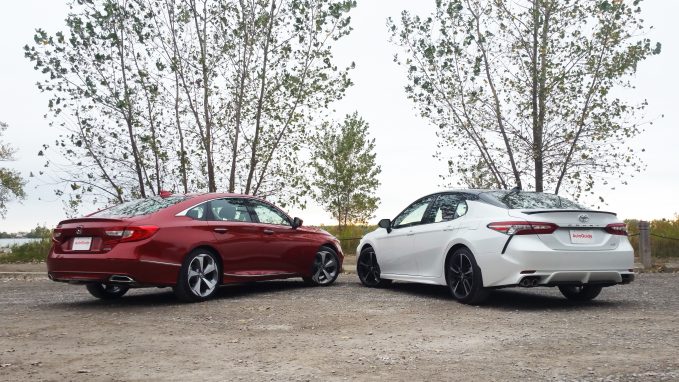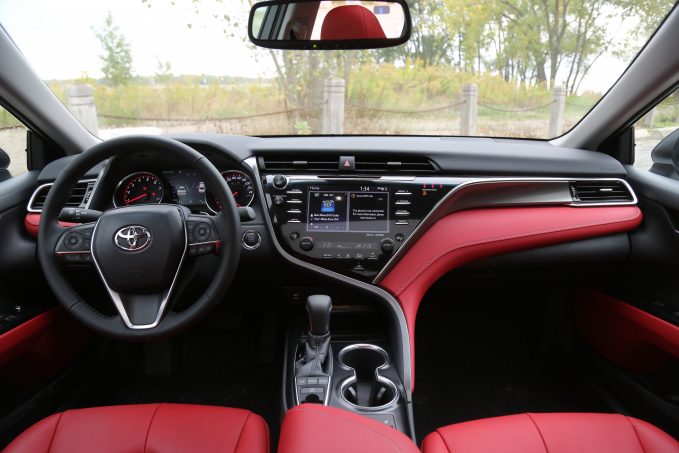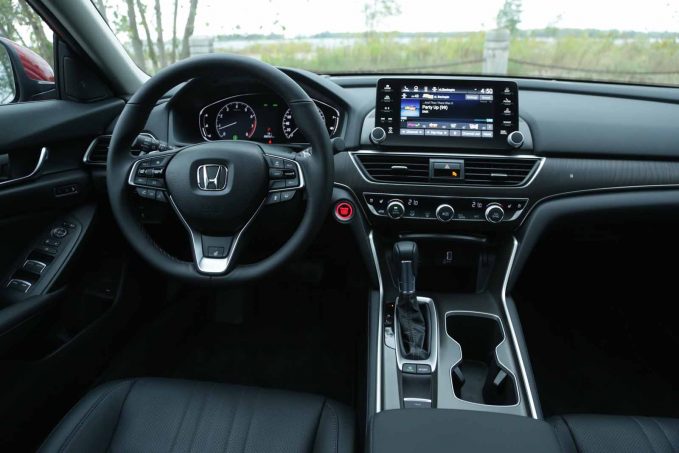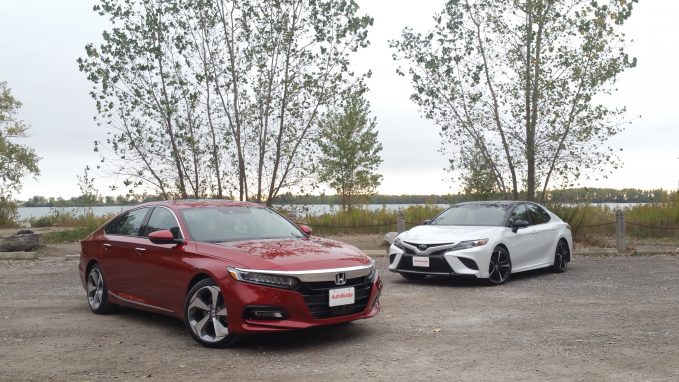History has its fair share of epic rivalries. Coke versus Pepsi, Tupac versus Biggie, Batman versus Superman. In the automotive sphere, Honda Accord versus Toyota Camry is one of the most hotly contested rivalries there is.
Both cars have been arm wrestling for family-sedan supremacy for decades and have come to this fight fully overhauled for the 2018 model year, so of course it was time to bring them both together to see which one is the better car.
Get the Flash Player to see this player.
Style
On the design front, Toyota has been going on a style rampage recently after getting a mandate from its CEO to stop making boring cars. Some might not like the Camry’s new look (its designers had the audacity to call it sexy), but it definitely can’t be classified as boring anymore. While some people find its design overwrought with too many fake vents, a massive in-your-face grille, and a mishmash of seemingly random angles, others find it aggressive and attractive. Its new available quad tailpipes, rear diffuser, and contrast black roof really increase the aggressiveness to a level that has never been seen on a Camry before but might be a bit overkill on a family sedan.
The Accord, on the other hand, takes a more understated approach. With a new sportback design, the Accord has an easy-to-digest and less polarizing cohesive design that helps it look more expensive than it actually is. The design of the Honda isn’t perfect — something about the grille dominated by a chrome unibrow and a lot of black plastic doesn’t quite sit right — but its cleaner lines, swoopy curves, and tidy proportions could appeal to more people simply because it might age better than the Camry. While some people accuse the Honda of looking boring, others seem to prefer its simple sophistication.
Compare Specs
Same Story Inside
Both cars are trying to look more upscale than before, but the ethos used for the exterior design carries over to the interior design as well.
The Camry’s risk-taking with design is also obvious inside. With an eye-catching asymmetrical dashboard layout and the availability of bright red leather seats, it certainly stands out from the crowd in a good way. Except for a few cheap-feeling plastics, the materials used inside are also high quality and everything seems screwed together tightly.
Honda definitely didn’t take as many risks with its more traditional layout and design, but the materials used are all close to meeting luxury car standards and the build quality is obvious, more so than the Toyota. The interior as a whole is more thought out and exhibits a higher attention to detail than the Camry. With the Accord, it’s the little details that make its interior smarter than the Camry — stuff like buttons that are more clearly labeled and intuitively placed or a wireless charging pad that can be hidden away just make it more user-friendly.
All the Tech You Could Want
All 2018 Camrys now come standard with Toyota Safety Sense P, which includes important safety features like collision mitigation with pedestrian detection, adaptive cruise control that works in stop-and-go traffic, lane departure alert with steering assist, and automatic high beams. Some models are also available with blind spot monitoring with rear cross traffic alert and a top-down parking camera.
To contrast that, 2018 Accords also come standard with Honda Sensing, which pretty much offers all the features that the Camry does. In terms of safety, the two cars are pretty equally matched. The Accord’s adaptive cruise control, however, is smoother to use and feels more natural. The Camry’s system leaves too much space between you and the car in front, even on its least sensitive setting, and cars just end up cutting in, and then it slams on the brakes, making the whole thing a bit jerky. The Accord seems to brake and accelerate more evenly.
Both cars are also available with features like wireless charging, mobile hotspot capability, and a head-up display, although the Honda has a few things the Camry doesn’t, like Apple CarPlay and Android Auto, a capless fuel filler, ventilated seats, and NFC communication. I also prefer Honda’s new infotainment system over the Camry. The graphics are cleaner and more modern, the menus are easier to navigate, and the intuitive setup makes it easy to master.
The Camry’s system is just a bit more confusing and seems a generation behind Honda’s, but it’s still a big improvement from before. The 360-degree top down parking camera is also a nice touch and something Honda doesn’t offer. One big downside of the Camry is that it is not available with an optional native navigation system unless you get the XLE or XSE V6 model — drivers would have to use Toyota’s proprietary app on their phone to access navigation for all other Camrys. Honda’s navigation is available on a wider range of models and is standard on the top Touring trim for both engines.
With 16.7 cubic feet, the Accord has a bigger trunk than the Camry, which has 15.1 cubic feet. The back seats in both sedans are also very generous with their passenger space, although the Accord’s sportback design seems to allow for a bit more headroom.
The Drive
It’s easy to be impressed by how the Camry drives now because it feels completely different than it used to. Toyota actually made me drive the new Camry on a race track, which it wouldn’t have done unless it was trying to prove a point. The point is that the Camry isn’t a spongy mess to drive anymore. No, it wasn’t fun to drive on a track, but the improvements to its driving dynamics became immediately obvious.
ALSO SEE: 2018 Honda Accord Pros and Cons
It’s not going to elevate your heart rate with sports car driving dynamics, but the Camry drives very decently. The steering has a heavy weight to it and exhibits a newfound responsiveness, and the suspension is even a lot stiffer than it used to be, which means the sedan feels more confident and less sloppy in a corner than it used to. The four-cylinder model is punchy enough, although Toyota is bucking the trend by continuing to offer a V6 option. The optional 3.5-liter V6 makes 301 horsepower and 267 pound-feet of torque and it’s hooked up to a smooth eight-speed transmission.
The base engine is a 2.5-liter four-cylinder model, and it’s interesting because it’s not turbocharged yet still feels pretty alive with 203 hp and 184 lb-ft of torque. With both engines, passing someone or getting up to highway speeds is no issue at all, and the V6 offers some much-appreciated urgency.
The Honda also gets two engine options, although unlike the Camry, it is no longer available with a V6. The base 1.5-liter turbocharged four-cylinder engine, which gets a CVT or a six-speed manual, outputs 192 horsepower and 192 pound-feet of torque, which is more than the previous model. The upgraded 2.0-liter turbocharged four-cylinder engine (which is a detuned version of the one in the Honda Civic Type R and gets paired to a new 10-speed transmission or the manual), outputs 252 hp and 273 lb-ft of torque.
ALSO SEE: 2018 Honda Accord Review
Historically, the Honda Accord has always been the better driver of the pair, but with this new generation of models, the differences are less stark. The way the Accord drives isn’t too different from the Camry drives. I have no real complaints about driving dynamics for both cars. They’re both smooth, predictable, easy and very good at doing what they’re supposed to be doing, which is operating in the background without any drama.
Like the Camry, the Accord has a heavier steering setup and a more rigid chassis so it too feels better in a corner. Driven back to back, the Accord’s steering, handling, and body control seem sharper than the Camry, but it’s not a huge difference, especially for most drivers who don’t’ care about canyon carving. The Sport mode in the Accord also makes more of a difference, making the car a bit sharper in all regards. The Camry’s sport mode doesn’t seem to do that much.
ALSO SEE: 2018 Toyota Camry Pros and Cons
The four-cylinder Camry LE has a fuel economy rating of 28 mpg city, 39 highway, and 32 combined (8.1/5.7/6.9 L/100 km), which is not too far off from the 1.5L and CVT-equipped Honda Accord’s 30/38/33 mpg ratings (7.9/6.3/7.2 L/100 km).
And what about pricing? Pricing has gone up a bit from last year, but Honda packs the new Accord with more standard features, which helps justify the increase. Pricing for the 2018 Honda Accord starts at $24,445 ($28,212 in Canada) and tops out at $36,675 ($40,612), while the Camry starts at $24,390 ($28,105 in Canada) and tops out at about $35,845 ($42,205).
The Verdict: 2018 Honda Accord vs Toyota Camry
It is harder than ever to pick a winner between these two cars. They’re both exceedingly good at what they do — they drive decently, come standard with a bunch of really useful safety features and technology, and both offer a higher-end experience than they used to. The Honda Accord, however, just seems to be smarter, sharper, more user-friendly, and as a whole, offers a more complete and cohesive package. Add in the fact that the style will age more gracefully, and it’s easily the best car in this segment. The Camry is a really good car, but the Accord is just that much better.
Honda Accord
Toyota Camry












